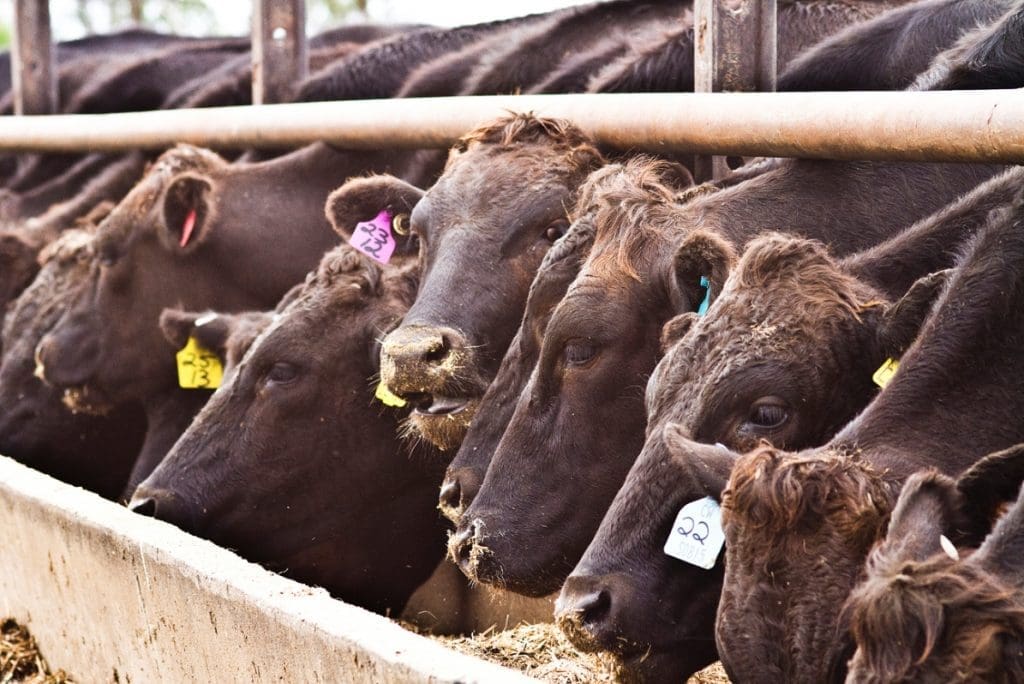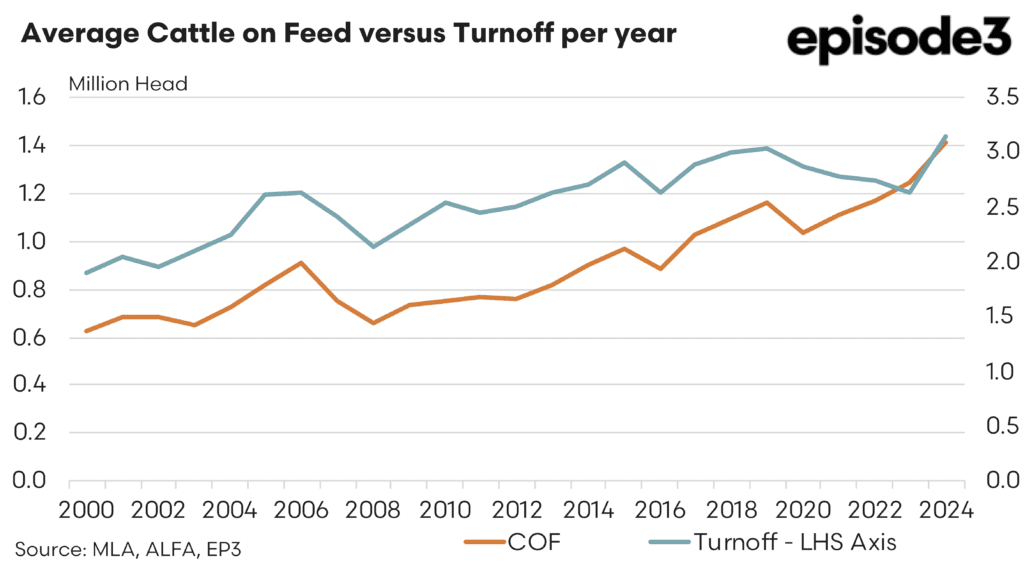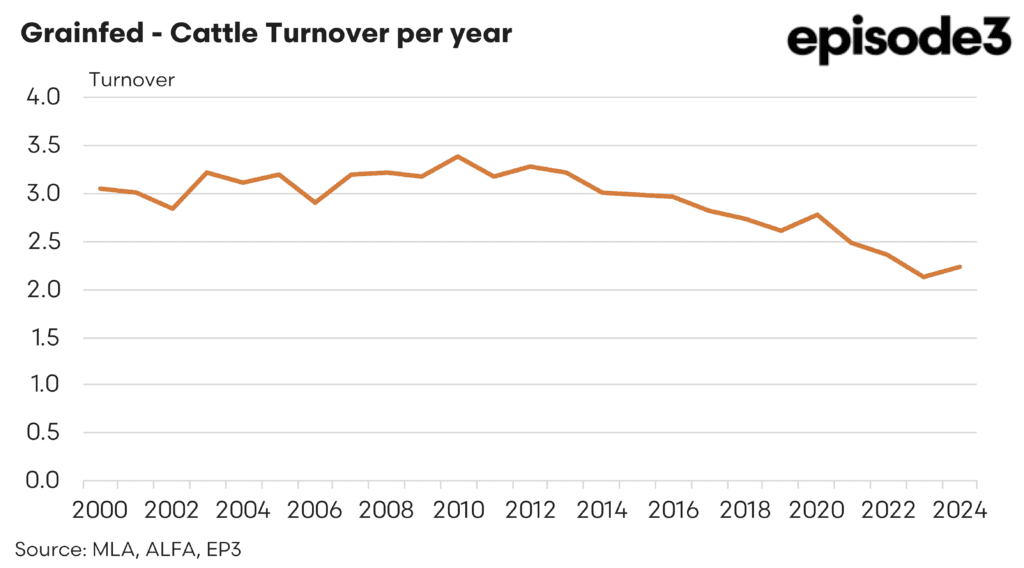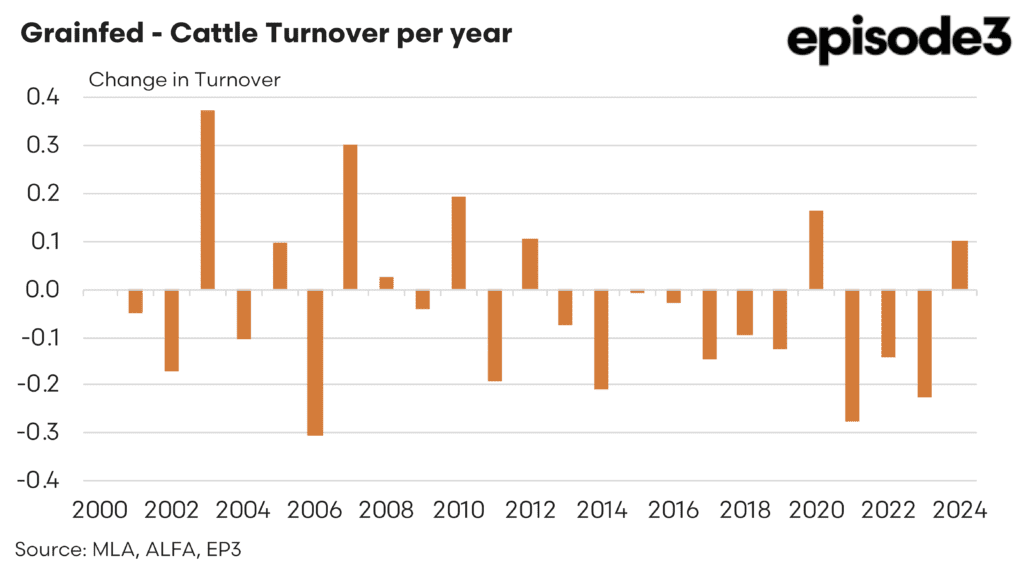
THE Wagyu sector is exerting a big influence on average days on feed for cattle in Australian feedlots, which last year and the year before hit record highs.
Annual average numbers of cattle on feed in Australia have grown from around 623,000 head in the early 2000s to record levels of 1.45 million head as at the end of 2024. Over the same timeframe grainfed slaughter numbers increased from 1.9 million head to 3.1 million per annum.
In percentage terms, the number of cattle on feed has lifted by 127 percent over the last 25 years, while the number of cattle turned off that were grain finished has increased by 65pc.
Such strong growth in feedlot numbers with grainfed slaughter volumes lifting by a smaller amount can only mean one thing: cattle in the feedlot system being held for longer.

Indeed, we can measure average cattle turnover per year relatively easily using the annual figures provided by the Australian Lot Feeders Association and MLA has part of the quarterly survey.
Dividing the annual turnoff per year by the average number of cattle on feed over the year allows measurement of how many times per year that cattle have been replaced nationally.
For much of the 2000 to 2016 period, the annual cattle turnover in the Australian feedlot system ranged between 2.9 to 3.4 times per year. However during 2017-18 this ratio of turnover began to trend downwards towards 2.6 turnovers per year. In recent years the turnover ratio has dipped again to a low of 2.1 per year in 2023.

Analysis of the change in cattle turnover each year from 2000 to 2024 highlights that during the 2000 to 2016 period, much of the change in one year was reversed in subsequent years. However in the last decade there has been a steady erosion of the cattle turnover ratio, particularly evident from 2017 to 2019 and 2021 to 2023. This suggests an extended period where cattle have been held for longer on feed, on average each year.
In the last decade we have noted a rise in the proportion of Wagyu cattle in the national herd, particularly F1 feeder types, and also an increase to longer fed Angus programs. This would account for the reduction seen in the cattle turnover ratio in recent years.

The number of cattle on feed for more than 300 days saw a significant lift during 2018 with numbers almost doubling from 2017 levels. A further large jump in numbers of cattle on feed for more than 300 days was seen in 2024. However longfed Angus these days are typically fed less than 300 days – with 270 days being a common limit.
The current rise in +300-day fed cattle is attributed to an increase in the proportion of Wagyu cattle being held in Australian feedlots.

The result of greater numbers of longfed Wagyu and Angus cattle in Australian feedlots has seen the days on feed (DOF) average begin to climb steadily since 2016. For much of the 2000 to 2017 period the average DOF ranged from 108 to 129 days, and averaged 118 days.
Since 2017 onwards, the average number of DOF has increased towards the high 160s. It peaked at 172 days in 2023 and has eased to 164 days as at the end of 2024.

Source: Episode3

My experience of 15/16 Wagyu cows, calves and growers over 7 years on grass only is that they are lazy eaters and therefore slow growers. I killed a 5 yr old 31/32 steer and the meat was terrible.
A R4yr AxW was very good however.
I am now selling 500 kilo Friesian bulls at 500 days off the same block.
Wagyu and Wagyu X’s were initially intended for the restaurant or fine dining sectors. In the last 10 years a lot of farmers have jumped on the band wagon for “higher profits” of wagyu therefore increasing the national herd of Wagyu & Wagyu x. But with the drop in price per kg in liveweight trading especially with heifers, many have been retained as heifers don’t sell well, they then tend to keep heifers to be crosses back to Angus or other beef breeds making many of the feedlot animals slower to mature and gain weight.
If we as an industry wish to provide more sustainable beef so as to maintain social acceptance, then I don’t think feeding cattle for 300 and 400 days is acceptable.
After all that is 200 to 300 days of feed to produce fat regardless of what the resultant eating experience is.
Great article. Do you have a contact address for Matt so I could get some more information and advice from him?
Contact details on the Episode 3 website, Rip – https://episode3.net/